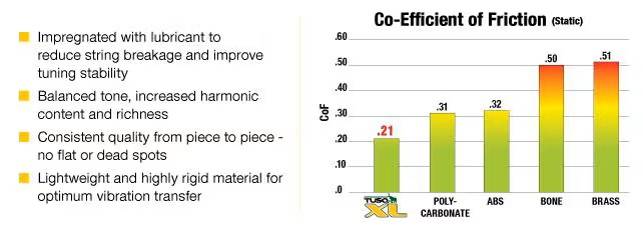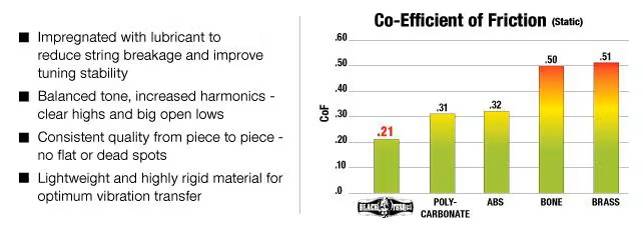Choose your nut material
Graph Tech has created specific materials so you can get the most our of your instrument.
Whether you have an electric guitar or bass, acoustic, ukulele or mandolin, we have options for you.

TUSQ® produces more harmonics in the mid and upper range of the guitars. TUSQ® nuts have harmonically rich tone, without the inconsistency found in ivory, bone or other natural materials. Bone and Ivory have hard and soft spots (grain) throughout each piece, hampering consistent transfer of vibrations to the guitar top. TUSQ® has been designed to transfer the right frequencies more efficiently from the strings to the guitars body.
Guitar | Bass | Blanks | Classical | Uke | Mandolin

TUSQ XL® is designed to boost guitar tone and performance. TUSQ XL® boosts harmonic content, increases tuning stability for big string bends, aggressive playing and/or heavy tremolo use all while keeping the vintage look of a white nut. TUSQ XL® has the great tone of TUSQ®, classic good looks and permanent lubrication.

Guitar | Bass | Blanks

Black TUSQ XL® is permanently lubricated for improved tuning performance and boost guitar tone. These precision engineered nuts are made with a specially formulated material which couples the strings vibration to the neck and brings out the hidden harmonics and richness in every note.

Guitar | Bass | Blanks | Classical | Uke | Mandolin
Enhance Your Guitar's Performance: Why You Should Change Your Nut?
No matter what type of stringed instrument you have, the nut is one of the most important parts of the overall performance, playability and tone of your instrument.
The effect of upgrading this small part will have an amazing effect on the health of your instrument.
When nuts are worn out or poorly constructed, problems such as string buzz, fretting out and tuning performance are just a matter of time.
Graph Tech precision molds and engineers its nuts to create the most consistent tone and string balance, as well as precise string spacing to create the perfect piece for your instrument.
Available Nut Options for Your Guitar
Pre-slotted nuts
Almost all of the work is done, all that is needed is final fit for length, height and thickness.
Nut blanks
Nut blanks have some shaping done but slots slots will have to be cut as well as final fit for length, height and thickness
Nut slabs
Nut slabs are simply a block of material that can be used to make the entire nut (or anything else) from scratch.
*Our nuts are engineered to accept string sets between 9-42 to 11-49 gauges on all electric nuts, 10-47 to 12-53 on acoustic nuts, and 40-95 to 50-105 on bass nuts, all without modification. Our materials can easily be modified to accept larger gauge sets with appropriate files.
Know your guitar's make & model? Check out.
Graph Tech has created some of the world's most recognized products and brands in the music industry
The list of industry firsts include the world's first self-lubricating nut in 1983, String Saver Saddles the first saddle to drastically reduce string breakage, TUSQ man-made ivory, and Ratio machine heads.





